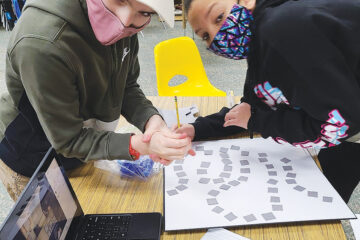Love letters in Judaic art
The Love Letters
David Moss explored creativity until he found his calling
Jack Moss always insisted of his children: be curious and creative. David Moss has certainly followed that advice.
At first, he didn’t want to go to college. He not only ended up in college, but at a small, private one where the curriculum consisted of studying classic books.
A native of Dayton, he grew up in a classic Reform Jewish home. “No kippah, no tallit, no Hebrew,” he said. Moss is now a devout, modern Orthodox Jew.
Moss “never had an interest in art,” and yet today, he is one of the world’s celebrated Jewish artists.
He explored education and creativity until he found his calling and his lifestyle.
He has become a renowned artist and sculptor. Among his several projects, he is known for reviving the art of the illuminated ketubah (wedding contract), his 1984 Haggadah, and his collaboration with Noah Greenberg on the Tree of Life Shtender, a magnificent prayer and study stand.
His most recent work is a book called The Love Letters, featuring his original ketubah art, including that of Daytonians Marsha Greenberg and his sister, Meredith Moss Levinson, who also wrote an explanation of the traditional Jewish wedding ceremony for the book.
Although The Love Letters will not be available to the general market until February, the Jewish Federation of Greater Dayton has begun selling the book through a special arrangement with Bet Alpha Editions.
Part of the proceeds from the book will benefit the Jewish Federation’s cultural arts programs.
The oversized book is cloth-covered and comes in a slip case. It also contains seven frameable, removable prints of the marriage blessings as well as Jewish quotes on love and marriage from the Bible to modern poetry.
The main portion of the book presents 63 images and details from marriage contracts Moss has produced.
Moss began to revive the handwritten ketubah process in the early 1970s, and has been involved in many successful art projects since.
A graduate of Meadowdale High School, Moss said he had no interest in going to college until he spotted a magazine article about St. John’s College of Annapolis and Santa Fe, N.M.
He went to Santa Fe by train to emerge at a school that had about 80 students and no text books, just classic books.
“The first year was all Greek,” Moss said. “The second year was Latin. The Jewish community had about 25 families.”
For some reason, he began to build a more Jewish life. He learned Hebrew on his own. He started keeping kosher.
“I realized I had a good background and knowledge of Western civilization,” Moss said. “At the same time, I didn’t have the Jewish piece. It was worth my while to spend some time to cure that ignorance.”
Rabbi Jack Riemer of Dayton’s Beth Abraham Synagogue encouraged Moss to apply to the Jewish Theological Seminary, but he needed more of a Hebrew background and went to live in Jerusalem in 1968-69.
“It was a very formative year,” Moss said. “It was the first year I lived in a real Jewish environment. That’s where I started calligraphy. I loved it.”
When he returned to the States, Moss did enter the seminary and studied there for two years, although he had little intention of becoming a rabbi.
“I’m very grateful for the seminary,” Moss said. “I went there just to learn.”
On a subsequent trip to Israel, he met his future wife, Rosalyn, who is from Chicago.
Today, their main residence is in Jerusalem, where they live near their four daughters, two of whom are married.
A third will be married in October and the fourth just entered the Israeli army.
In addition to his work in all forms of art, Moss is currently working in Jewish architecture, helping groups such as the UCLA Hillel, a Dallas day school complex and the Jewish Federation in New York develop buildings around Jewish themes.
As for The Love Letters, the pre-publication price through the Dayton Federation is $175 for the book, which will sell for $200 on the general market.
Moss will also sign a wedding edition of the book, available in leather binding, for $300 until general publication in February, when it will sell for $360. For more information, contact Joan Mayrer at JMayrer@jfgd.net.





